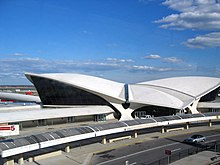Eero Saarinen
Eero Saarinen (/ˈeɪroʊ ˈsɑːrɪnən, ˈɛəroʊ -/, Finnish: [ˈeːro ˈsɑːrinen]; August 20, 1910 – September 1, 1961) was a Finnish-American architect and industrial designer who created a wide array of innovative designs for buildings and monuments, including the General Motors Technical Center in Warren, Michigan; the passenger terminal at Dulles International Airport outside Washington, D.C.; the TWA Flight Center (now TWA Hotel) at John F. Kennedy International Airport; the Vivian Beaumont Theater at Lincoln Center in New York City; and the Gateway Arch in St. Louis.
[1][2] He grew up in Bloomfield Hills, Michigan, where his father taught and was dean of the Cranbrook Academy of Art, and he took courses in sculpture and furniture design there.
[3] He had a close relationship with fellow students, designers Charles and Ray Eames, and became good friends with architect Florence Knoll (née Schust).
[5][1] He subsequently toured Europe and North Africa for two years, as well as working for a time in Helsinki in the office of architect Jarl Eklund, where he supervised the remodeling of the Swedish Theatre (1936).
The first major work by Saarinen, in collaboration with his father, was the General Motors Technical Center in Warren, Michigan, which follows the rationalist design Miesian style, incorporating steel and glass but with the addition of accent of panels in two shades of blue.
The GM Technical Center was constructed in 1956, with Saarinen using models, which allowed him to share his ideas with others and gather input from other professionals.
Saarinen served on the jury for the Sydney Opera House commission in 1957 and was crucial in the selection of the now internationally known design by Jørn Utzon.
Another thin-shell structure is Ingalls Rink at Yale University, which has suspension cables connected to a single concrete backbone and is nicknamed "the whale".
His most famous work is the TWA Flight Center at John F. Kennedy International Airport, which represents the culmination of his previous designs and his genius for expressing the ultimate purpose of each building, what he called the "style for the job".
Saarinen was assigned to draw illustrations for bomb disassembly manuals and to provide designs for the Situation Room in the White House.
[19] In 1940, he received two first prizes together with Charles Eames in the furniture design competition of the Museum of Modern Art in New York City.
Saarinen met Louchheim when she came to Detroit to interview him for his contributions to the recently completed General Motors Technical Center.
[23][24] In addition to their respective contributions to architecture, design, and criticism, Eero and Aline Saarinen are remembered for their affectionate and detailed personal papers, held at the Archives of American Art.
He was criticized in his own time—most vociferously by Yale's Vincent Scully—for having no identifiable style; one explanation for this is that Saarinen's vision was adapted to each individual client and project, which were never exactly the same.
[29] The Eero Saarinen collection at the Canadian Centre for Architecture documents eight built projects, including the old Athens airport in Greece, the former US Embassy Chanceries in Oslo, Norway and London, England, corporate projects for John Deere, CBS, and IBM, and the North Christian Church in Columbus, Indiana.
The exhibition toured in Europe and the United States from 2006 to 2010,[31] including a stint at the National Building Museum in Washington, DC.








